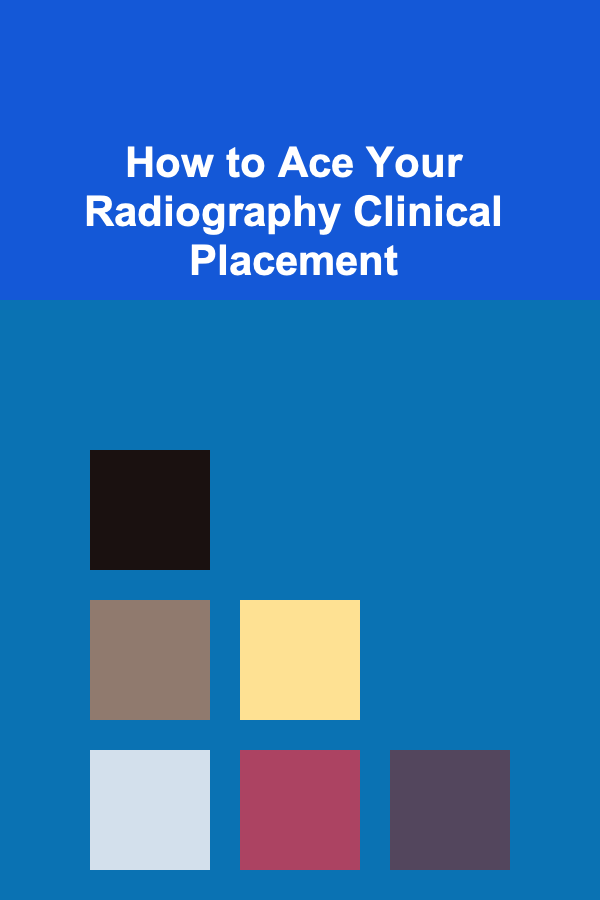
How to Ace Your Radiography Clinical Placement
ebook include PDF & Audio bundle (Micro Guide)
$12.99$8.99
Limited Time Offer! Order within the next:

Clinical placements are an essential component of your radiography education, offering an opportunity to apply theoretical knowledge in real-world settings. These placements not only build your technical skills but also provide an invaluable chance to gain experience working alongside healthcare professionals in fast-paced environments. However, navigating through clinical placements can be both exciting and challenging. Understanding how to excel during these periods is crucial to your success as a radiographer.
In this article, we will explore strategies, tips, and advice on how to make the most of your radiography clinical placement. By focusing on professional development, technical skills, communication, and self-reflection, you can significantly enhance your performance and ensure a rewarding learning experience.
Prepare Before Your Placement
Proper preparation can make a significant difference in how smoothly your clinical placement goes. While the specifics of each placement may vary, there are general steps you can take beforehand to set yourself up for success.
Research the Facility
Familiarize yourself with the hospital or clinic where you will be placed. Research their imaging departments, their technology, and the types of services they offer. Understanding the environment you're entering can help reduce anxiety and allow you to ask informed questions when you arrive.
Review Your Learning Objectives
Before starting your clinical placement, review the learning objectives and goals you are expected to meet during the placement. Being clear about these goals will allow you to track your progress and focus on the areas that need improvement.
Refresh Your Knowledge
It's a good idea to refresh your knowledge of anatomy, radiographic positioning, imaging techniques, and any specific protocols related to the type of radiography you'll be performing. This review will help you feel more confident as you approach clinical tasks.
Be Proactive and Take Initiative
Once your placement begins, one of the best things you can do is take initiative. Don't wait for opportunities to come to you---seek them out.
Volunteer for Tasks
Radiography placements can be busy, and there will often be multiple tasks that need attention. Volunteering to assist with tasks, even outside your core responsibilities, shows your enthusiasm and commitment to learning. This also allows you to gain a broader range of experience.
Ask Questions
Don't be afraid to ask questions. Whether you are unclear about a procedure, equipment, or patient interaction, seeking clarification shows that you are engaged and eager to learn. Healthcare environments are complex, and it's better to ask questions upfront than to make assumptions that could lead to errors.
Be Open to Feedback
Seek feedback from your supervisors, mentors, and colleagues. Feedback is invaluable for growth, and being receptive to both positive and constructive criticism will allow you to refine your skills. Additionally, be sure to implement any suggestions or adjustments they provide to improve your performance.
Develop Strong Communication Skills
As a radiographer, communication is key---not only in working with patients but also with your colleagues. Building strong communication skills will enhance your professional relationships and improve your performance during clinical placements.
Communicate with Patients Effectively
Effective communication with patients is critical to providing high-quality care. Patients may feel anxious or uncomfortable about the imaging procedures, and it's your responsibility to reassure them, explain the process clearly, and answer any questions they may have. Building rapport with patients can also help put them at ease, ensuring a smoother procedure.
Work Collaboratively with Your Team
You'll work closely with radiologists, nurses, technicians, and other healthcare professionals during your clinical placement. Being a team player, showing respect for others' roles, and actively participating in discussions will make you a valuable part of the team. Good communication also helps ensure patient safety and smooth operations in the department.
Develop Clear Documentation Skills
Accurate and clear documentation is an essential part of radiography practice. Make sure you are recording all relevant information properly. This includes patient details, imaging procedures performed, technical settings, and any unusual occurrences during the process. This practice will ensure that your work aligns with professional standards and helps maintain a high quality of care.
Master Radiographic Techniques
Your clinical placement is an excellent opportunity to master radiographic techniques in real-world settings. By honing your technical skills, you'll gain the confidence necessary to perform high-quality imaging procedures.
Focus on Positioning
Accurate positioning is critical to obtaining diagnostic images. During your placement, pay close attention to positioning techniques, and try to practice as much as possible. Ask your mentor for guidance if you are unsure about certain positions or angles. Correct positioning reduces the need for retakes and ensures that the images are diagnostically useful.
Understand the Technology
Radiography departments use sophisticated imaging equipment such as X-ray machines, CT scanners, MRI machines, and fluoroscopy units. Take time to understand how these machines work and familiarize yourself with the different settings and their applications. The more familiar you are with the technology, the more confidently you can operate it.
Focus on Image Quality
Quality control is a significant aspect of radiography practice. Pay attention to the quality of your images, and always assess whether you need to make adjustments. In cases where the image quality is suboptimal, be proactive in making the necessary changes, such as adjusting exposure settings or repositioning the patient.
Stay Up-to-Date on Safety Protocols
Radiography involves the use of ionizing radiation, so it's essential to stay up-to-date on safety protocols to minimize radiation exposure to both patients and staff. Always follow the ALARA principle (As Low As Reasonably Achievable), ensuring that radiation doses are kept to a minimum while still producing diagnostic-quality images. Always wear personal protective equipment (PPE) and ensure that patients are properly shielded.
Take Care of Your Wellbeing
While your clinical placement is a time for professional development, it's also important to take care of your physical and mental health. Healthcare environments can be stressful, so learning how to manage stress and maintain your well-being is vital.
Balance Work and Rest
Radiography can be physically demanding, with long shifts and a variety of patients to handle. Make sure to take regular breaks and rest when needed. Taking care of your body---whether through stretching, staying hydrated, or eating balanced meals---will help you perform at your best.
Manage Stress
Clinical placements can sometimes be overwhelming, especially when faced with difficult cases or heavy workloads. Find effective ways to manage stress, such as practicing mindfulness, deep breathing exercises, or simply taking a walk during breaks. Developing healthy coping mechanisms will help you stay calm and focused in challenging situations.
Stay Organized
In busy healthcare environments, it's easy to get overwhelmed by multiple tasks and competing priorities. Keep a detailed schedule of your tasks and appointments, and prioritize the most critical actions. Using organizational tools like checklists or planners can help keep you on track and prevent unnecessary stress.
Be Adaptable and Resilient
The healthcare environment is dynamic and can change rapidly, so it's crucial to be adaptable and resilient. Clinical placements may present unexpected challenges, and it's essential to remain flexible and ready to learn from any situation.
Learn from Mistakes
Mistakes are an inevitable part of learning, especially in a clinical setting. Instead of dwelling on errors, use them as an opportunity to learn and improve. Reflect on what went wrong, how you can do better next time, and seek guidance if necessary. Resilience in the face of setbacks is a vital trait for success in the healthcare field.
Embrace New Challenges
Every placement will offer unique challenges. Whether you are working in a high-pressure environment or dealing with unfamiliar equipment, embrace these new experiences. The more challenges you face and overcome, the more confident you will become in your abilities as a radiographer.
Develop Problem-Solving Skills
You'll encounter complex situations during your clinical placement, such as patients with specific medical conditions or challenges in achieving the required imaging quality. Practice problem-solving by thinking critically and considering all available options. This proactive approach will help you find solutions and improve your clinical reasoning skills.
Seek Mentorship and Build Professional Relationships
A clinical placement is an opportunity to learn from experienced professionals. Finding a mentor who can offer guidance and support can be incredibly valuable for your development.
Find a Mentor
Having a mentor, whether it's a senior radiographer or a clinical instructor, can provide insights into the profession and help you navigate challenges. A mentor can offer feedback, provide advice, and share their experiences, which can be incredibly valuable for your growth as a radiographer.
Build a Professional Network
Take the time to build relationships with other professionals in the field, such as radiologists, nurses, and technologists. A strong professional network can open doors for future career opportunities and provide a support system throughout your career.
Conclusion
Excelling in your radiography clinical placement is a rewarding experience that can shape your future career. By preparing thoroughly, taking initiative, honing your technical skills, communicating effectively, and focusing on personal wellbeing, you'll make the most of this opportunity. Remember that clinical placements are not only about mastering radiographic techniques but also about developing as a healthcare professional. Embrace the learning journey, be adaptable, and always strive for continuous improvement.
Reading More From Our Other Websites
- [Home Rental Property 101] How to Search for Houses for Rent with a Covered Patio
- [Organization Tip 101] How to Create a Vintage-Themed Workspace
- [Personal Investment 101] How to Use Real Estate as a Steady Investment Strategy
- [Organization Tip 101] Common Mistakes to Avoid When Installing a Garden Shed Foundation
- [Home Budget Decorating 101] How to Use Lighting to Elevate Your Home Decor on a Budget
- [Home Budget Decorating 101] How to Mix High-End and Budget Decor for a Polished Look
- [Home Rental Property 101] How to Choose Between Renting Furnished vs. Unfurnished Properties
- [Home Security 101] How to Make Your Home Safe for Kids: Top Home Security Tips
- [Soap Making Tip 101] Best Non‑Toxic Soap Stamps for Customizable Branding
- [Home Party Planning 101] How to Coordinate Home Party Catering for a Seamless Event

Engineering Health: Essential Skills for the Biomedical Engineer
Read More
How to Build a Strong Credit History from Scratch
Read More
How to Use Clipboards for Easy Sheet Music Storage
Read More
How To Use Adobe Photoshop for Beginners
Read More
How to Lead Diverse Teams Effectively
Read More
How to Build a Decentralized Voting System with Blockchain
Read MoreOther Products

Engineering Health: Essential Skills for the Biomedical Engineer
Read More
How to Build a Strong Credit History from Scratch
Read More
How to Use Clipboards for Easy Sheet Music Storage
Read More
How To Use Adobe Photoshop for Beginners
Read More
How to Lead Diverse Teams Effectively
Read More